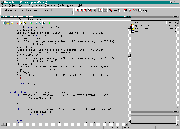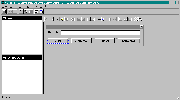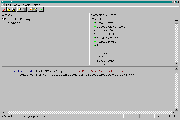
Java is either going to change the world, or it isn't.
I'm not much of a fan of Java. That's obvious. Still, it's not my job to decide what technologies other people should waste their time on. People are interested in Java, so it's my duty to write about it.
Nobody said I have to be objective, though, so here's my list of the Top 12 Reasons not to use Java:
Some people embrace Java of their own free will; others have it thrust upon them. If you're one of those unlucky souls who can't escape, or if you believe all the hype (remember Pen Computing?) and want to use Java, herewith a brief introduction.
If your browser is Java-enabled (as are Netscape Navigator 2.01 or later and Microsoft Internet Explorer 3.0), you should see a Java applet above. It's hopefully labeled "WinPost Search."
This applet is simple to the point of silliness. All it does is forward a search to one of four Internet search engines: Infoseek Ultra, AltaVista, Yahoo, or DejaNews. Though hardly Office 97, it does perform a useful function: if you submit a search through the applet, you don't have to wait for your chosen search engine's advertisement-raddled front page to load. You jump directly to the engine's advertisement-raddled results page.
To use the applet, you just type the word or phrase you want to search for in the "Search" field, then click the button for the engine you want to search. Simple. If everything works, you should see the search results page after a few moments.
Obviously, my little applet didn't spring into existence of its own free will. If it had, it would do something more interesting. So, what do you need to create a Java applet? First, you need to know the language.
Java is the Next Big Thing. Bookstore shelves groan beneath the weight of tomes on this new language that makes all preceding languages obsolete. By all means, peruse the selection and bring home a few of the heftiest; writers need to make a living too. If your funds only run to one treatise, I recommend "the Purple Book," also known as Hooked on Java (van Hoff, Addison-Wesley, 1996).
Hooked on Java isn't for amateurs. At 180 pages, it's very dense; more than 50 pages are devoted to screen captures of sample applets. Not much room to introduce a whole new language.
If you're already familiar with object-oriented programming (especially using C++), Hooked is a great book. It introduces the essentials of Java without spoon-feeding you basic programming techniques. Even better, once you've got the basics, Hooked functions as an excellent reference guide. It's well-organized for those moments when you need to look up some bit of Java arcana.
You'll still need a reference to the Java API; the book only covers the highlights. Java development tools like Symantec Café usually include a complete hypertext version of the Java API reference, which is probably better than a book anyway. The hypertext links allow you to understand and follow the intricate interrelationships between API classes.
 To build an applet, you'll need a Java development tool. The simplest, crudest,
and cheapest can be found at Sun Microsystems; they offer a free command-line
Java compiler, the Java
Developers Kit. This is no way to build real Java applets, but it can be a
way to get started in a pinch.
To build an applet, you'll need a Java development tool. The simplest, crudest,
and cheapest can be found at Sun Microsystems; they offer a free command-line
Java compiler, the Java
Developers Kit. This is no way to build real Java applets, but it can be a
way to get started in a pinch.
There are now several commercial Java development environments, such as:
My favorite is Symantec Café, which can be purchased online if you're in a hurry. It offers many of the features of real development environments like Microsoft Visual C++.
Café's debugger and source code editor are adequate, but its class browser and online help (including a complete hypertext API reference) really shine. The ability to view your code by class and member function is indispensable for Java development.
Building a Java applet is like programming in any other language, only more frustrating. Java is somewhat like C++, so if you know C++, you'll quickly manage to find all the ways Java isn't like C++.
 Fortunately, building the applet framework is no longer something you have to do
yourself. Most Java development tools will now create a basic applet for you
automatically. Some can even generate the code needed to display a form like the
one in my sample applet above.
Fortunately, building the applet framework is no longer something you have to do
yourself. Most Java development tools will now create a basic applet for you
automatically. Some can even generate the code needed to display a form like the
one in my sample applet above.
You might want to take a look at the source code and resource file for the sample WinPost Search applet. That should give you an idea what Java code looks like, if you've never seen any.
At this point, I must insert a disclaimer: I actually wrote only a few lines of the Search applet. Most of the code was generated automatically by Café.
To build the Search applet, I created a new project in Café. I then fired up Café Studio, the development environment's resource editor. I added a resource, the main form, and populated it with the label "Search:," the text field where you enter your search, and the four buttons. For each button, I added an event handler for the "click" event.
![]() When I closed Café Studio, the program automatically created a working Java
applet framework, including functions for the four click events. I take no
responsibility for the nasty
When I closed Café Studio, the program automatically created a working Java
applet framework, including functions for the four click events. I take no
responsibility for the nasty if statement in the handleEvent
member function; that was generated by Studio, as were the calls in the init
function that actually "create" the form.
In fact, the only function I wrote myself was SendQuery. That's
the function that creates the URL from the search text and engine selection,
then tells the browser to jump to that URL. The rest of the program was created
entirely automatically.
 Once I'd written the
Once I'd written the SendQuery function, I used Café's class
browser to add the appropriate SendQuery function call to each of
the four click event handlers. For each SendQuery call, I figured
out the URL prefix by looking at the HTML source of the relevant search engine's
front page.
Compile, test, and done! That's really all there is to it.
Once you've got a running Java applet, you need to put it somewhere it can be used. Though Java programs can be run on your computer using the Java Applet Viewer, you have to be fairly masochistic to use Java to develop desktop applications; so many better tools exist.
Java's usefulness comes from its ability to run within Web browsers. To embed a Java applet in a Web page, you use HTML tags like this:
<APPLET CODE="winpost.class" WIDTH=480
HEIGHT=86></APPLET>
The Applet tag is fairly straightforward. The Width and Height values
determine the size (in pixels) of the window in which the applet will run. The
Code value determines the name of the target applet's main class, winpost.class
in this case.
The Code parameter follows the same rules as the SRC parameter in the IMG tag. If no path is specified, the applet is assumed to reside in the same location as the HTML document that refers to it. However, you can just as easily place your applet in a different directory or even on a different server; just put the correct URL in the Code parameter.
The .class extension indicates compiled Java code. The .class
files for your applet will be created automatically by your Java compiler. There
will be a .class file for every public class in your applet; to
reduce download time, it's a good idea to reduce the number of public classes as
much as possible.
The Applet tag shown above is really the simplest possible embedding code. There are lots of other things you can do, such as supply parameters, and so on. These variations are described in some detail in Hooked on Java.
One important note: Java uses file extensions that are longer than three
characters, in particular, .class and .java. For this
reason, it tends to be hard to host Java applets on a DOS system. If you are
developing under DOS (heaven forbid) or under Windows 3.x, you need to
make sure these extensions are respected when your pages arrive on the server
(especially .class); if you don't, your applets probably won't
work.
When a browser downloads a page containing an applet, it immediately launches its Java Virtual Machine (or "just in time" Java compiler, in some cases) and passes control to the applet's startup method. Your applet can be running before the page has fully downloaded.
The applet will continue to run until it terminates itself or the browser jumps to another page. If someone brings their browser "back" to the page containing your applet (using the "back" button or equivalent), at least some of the applet's state will be preserved. Text fields, for example, will keep their contents. I've had varying results with this feature, including some spectacular crashes, so I wouldn't rely on a Java applet working properly under these circumstances.
If a browser that doesn't support Java downloads a page containing an applet, the Applet tag is just ignored (one of the major strong points of HTML).
That pretty much covers the basics, and should give you enough information to get into plenty of trouble.
The official Java site is a good place to start. Since the Java and Javascript worlds are changing pretty fast, I recommend looking in the Yahoo Java Resources page to find interesting new sites. There's also the unofficial Java applet clearinghouse Gamelan; that's a great place to find applets, many with source code so you can see how the magic gets done.
After seeing an applet like WinPost Search developed in fifteen minutes, you can see how the Javaheads out there believed their language would change the world: a useful little program created with almost no effort. Sadly, it works this way because I chose my tiny applet's task very carefully. There are many equally simple-sounding tasks that would need thousands of lines of Java code to develop.
It's also worth noting that the applet's user interface is incredibly primitive when compared to even the simplest Windows 95 application. I stuck to Java's pathetic set of built-in controls and didn't do anything to change their default appearance. Nobody used to typical Windows applications would be satisfied with WinPost Search if it wasn't a free test application.
The problem with Java, finally, is that it's just a programming language, and not a very well-designed one at that. Expecting it to change the world, destroy Microsoft, and all those other things is insanity. It's people, not programming languages, that change the world.
![]()